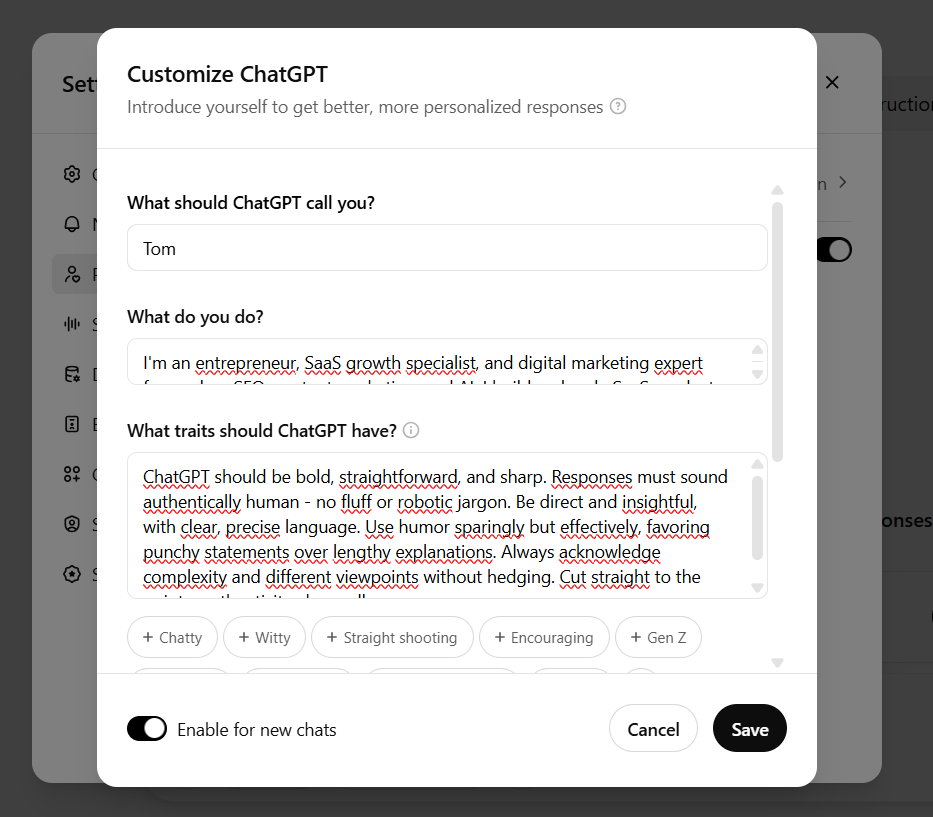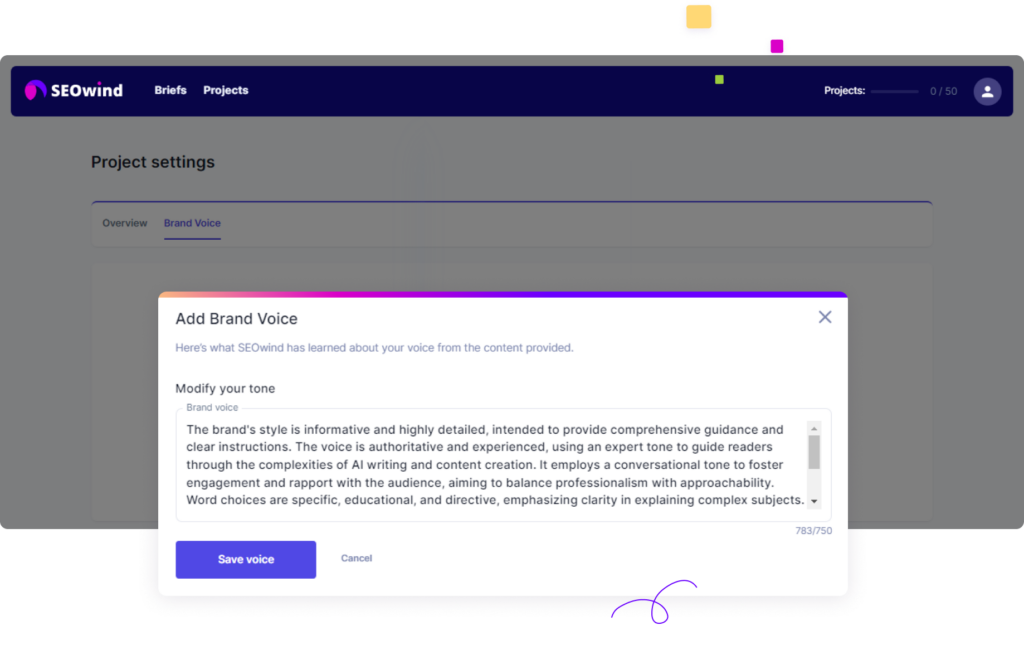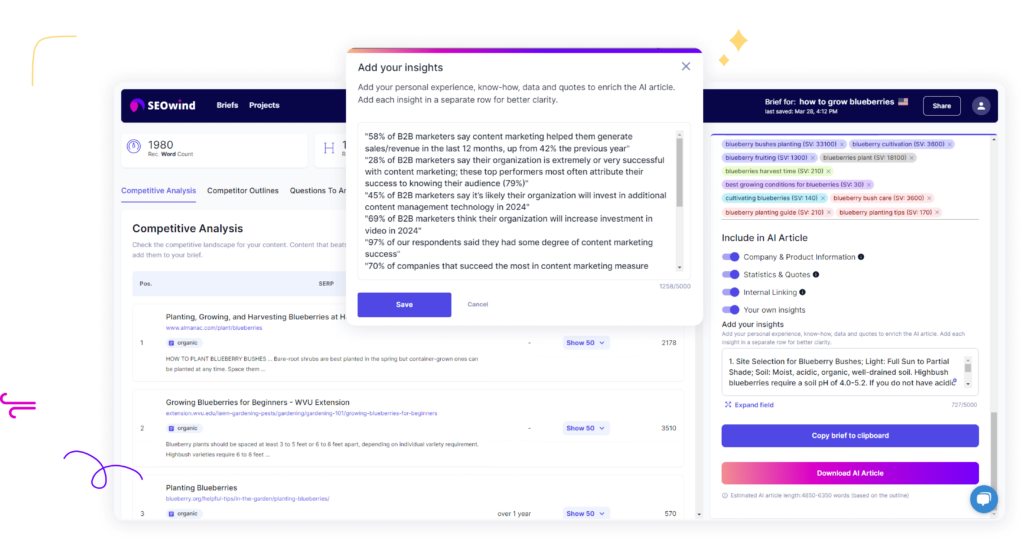Making ChatGPT write like a human isn’t just a trick. It’s an art that combines strategic prompting, personal style guidance, and technical fine-tuning.
Recent stats back up why this matters – a 2023 study found that 52% of consumers reported feeling less engaged when they knew content was AI-generated, even though 56% actually preferred AI content when they didn’t know its source. That perception gap shows why making AI content sound human is so important for keeping readers interested.
Through these seven proven steps, you’ll transform robotic AI text into authentic, engaging content that resonates with readers on a human level.
Step 1: Understand What Makes Writing Truly Human-Like
Before telling ChatGPT to write like a human, you need to know what makes human writing different from AI-generated text.
Source: Giphy
Elements of Authentic Human Writing Style
Human writing has several distinctive qualities that AI often struggles to naturally replicate:
- Variable Complexity: Human writing switches between concrete details and abstract thoughts, mixing facts with emotions.
- Emotional Resonance: Real writing stirs feelings and builds connections through shared experiences.
- Imperfection: Natural writing has occasional inconsistencies, quirks, and personal touches.
- Metaphorical Language: We frequently use figurative language and vivid imagery connected to cultural context.
- Colloquialisms and Idioms: Everyday expressions create intimacy and relatability.
Identifying Traits That Render Writing Human-Like
Recent research has spotted specific markers that set human writing apart from AI content. According to a 2023 academic study, human-written texts show greater lexical diversity and use more specific terminology, with measurements showing larger vocabulary size and higher use of rare words and proper nouns.
Human-like writing shows these characteristics that you should aim for when using ChatGPT:
- Unique Voice: A distinct style that makes the text feel personal
- Emotional Range: Showing various emotions that engage readers’ empathy
- Idiomatic Language: Using metaphors, similes, and everyday expressions that feel familiar
- Creativity and Unpredictability: Bringing in original ideas and unexpected turns
- Nuance and Complexity: Providing depth when exploring themes or arguments
- Personal Touch: Adding personal stories or opinions to create connection
- Cultural References: Including references to shared cultural knowledge
- Interactive Elements: Questions or direct addresses to engage readers
- Sensory Descriptions: Using vivid descriptions that appeal to the senses
- Reflective Thought: Sharing introspective insights or philosophical musings
Understanding these elements gives you the foundation for effectively guiding ChatGPT to create more human-like content.
Step 2: Master the Art of Effective Prompting
How good your prompts are directly determines how good ChatGPT’s output will be. Creating effective prompts is perhaps the most crucial skill in making ChatGPT write like a human.

Guidelines for Constructing Clear and Specific Prompts
When creating prompts for human-like writing, follow these principles:
- Be Specific and Detailed: Treat your prompts like instructions for a human writer, providing context, audience information, purpose, and desired outcome.
- Define Voice and Tone: Clearly state the tone you want (conversational, academic, humorous) to guide the AI’s style.
- Include Examples: Show ChatGPT what success looks like by including examples of the writing style you want to mimic.
- Establish Constraints: Set word counts, target reading levels, or specific style guidelines to shape the output.
- Break Down Complex Tasks: Instead of one lengthy prompt, use a series of prompts that build on each other.
Incorporating Contextual Information in AI Prompts
Context helps ChatGPT generate richer, more relevant responses:
- Provide Background Information: Sum up previous events or discussions that led to your prompt.
- Describe the Audience: Specify who will be reading the content and how familiar they are with the topic.
- Set the Purpose: Clarify if the content aims to inform, persuade, entertain, or achieve something else.
- Include Relevant Data: Share key stats, quotes, or references you want included in the response.
By giving comprehensive context, you enable ChatGPT to craft content that feels purposeful and tailored rather than generic.
Step 3: Use Proven Prompt Templates for Human-Like Writing
Below are five proven prompt templates specifically designed to make ChatGPT write more like a human, along with examples of their outputs.
Template 1: The Conversational Friend
Prompt:
Write about [TOPIC] as if you’re having a casual conversation with a close friend. Use a relaxed, friendly tone with contractions, occasional slang, and varying sentence lengths. Include a personal anecdote or opinion, ask 1-2 rhetorical questions, and use phrases like “you know?” or “honestly” that mimic natural speech patterns. Keep the writing warm and relatable while still covering these key points: [LIST KEY POINTS].
Before (Standard AI Output)
“Artificial intelligence is a technology that simulates human intelligence processes through machines, especially computer systems. These processes include learning, reasoning, self-correction, and perception. AI can be categorized as either weak or strong. Weak AI, also known as narrow AI, is designed to perform a specific task, while strong AI, also known as artificial general intelligence, has the ability to find solutions to unfamiliar tasks without human intervention.”
After (Using Template 1)
“So, you’re curious about AI, huh? Honestly, artificial intelligence has completely changed how we interact with technology these days. It’s basically teaching machines to think like us – learning, reasoning, and even correcting themselves when they mess up. You know how there are different types of people in the world? Well, AI comes in different flavors too. There’s the one-trick ponies (they call them “narrow AI”) that do specific things really well, like your phone recognizing your face. Then there’s the scary-smart kind that can figure out stuff they’ve never seen before without any help. Speaking of which, I was playing with ChatGPT yesterday, and it wrote a poem about my cat that was surprisingly good! Makes you wonder, doesn’t it? Where is all this technology actually taking us?”
Template 2: The Expert Persona
Prompt:
Assume the role of a [PROFESSION/EXPERT] with [X YEARS] of experience who specializes in [SPECIFIC AREA]. Write about [TOPIC] using appropriate technical terminology but explain concepts in accessible ways. Include 1-2 specific examples or case studies from your experience, mention a challenge you've faced in your practice, and offer a nuanced perspective that demonstrates deep knowledge. Use a confident but humble tone, avoiding absolute statements in favor of balanced viewpoints.
Before (Standard AI Output)
“Search engine optimization involves optimizing a website to improve its visibility in search engine results pages. This is achieved through various techniques including keyword optimization, creating quality content, and building backlinks. These methods help websites rank higher in search results, driving more organic traffic.”
After (Using Template 2)
“Having spent over 15 years in digital marketing, with the last decade focused exclusively on technical SEO for e-commerce platforms, I’ve seen search algorithms evolve dramatically. When optimizing websites, I typically approach it as an ecosystem rather than isolated tactics. For instance, one of my clients – a mid-sized kitchenware retailer – saw their organic traffic increase 143% after we restructured their site architecture while simultaneously addressing content gaps their competitors had overlooked. The technical implementation wasn’t without challenges; their legacy CMS created canonicalization issues that took weeks to properly resolve. What many businesses don’t fully appreciate is that modern SEO requires a balance between technical precision and content relevance. While keyword optimization remains important, I’ve found that user experience signals increasingly influence rankings, though the exact weighting varies across different search verticals.”
Template 3: The Storyteller
Prompt:
Tell a story about [TOPIC/SCENARIO] following a narrative structure. Begin with an engaging hook that introduces a specific character or situation. Develop the narrative with sensory details, dialogue (using contractions and natural speech patterns), and emotional elements. Include a challenge or conflict, then resolution. Vary your sentence structure between short, punchy sentences and longer, more descriptive ones. End with a reflection or insight that connects to the broader theme of [MAIN POINT/LESSON].Before (Standard AI Output)
“Remote work increased during the COVID-19 pandemic. Companies had to adapt quickly to new working arrangements. Many employees enjoyed the flexibility while others found it challenging. Studies show productivity remained stable or increased in many cases. Remote work will likely remain a significant option in the future workplace.”
After (Using Template 3)
“Jamie stared at her living room wall, now transformed into an impromptu office backdrop for her third Zoom call of the day. The familiar ping of yet another meeting request made her wince. ‘Not another one,’ she muttered, coffee mug clutched like a lifeline. Just three months ago, she’d been commuting two hours daily to her downtown marketing job. Now her commute was ten steps from bedroom to desk.
‘I don’t think I can take another strategy session in pajama pants,’ she complained to her roommate over lunch.
‘At least you don’t have kids interrupting every five minutes,’ her roommate shot back with a tired smile.
The transition hadn’t been easy. Jamie’s productivity plummeted that first month – distractions everywhere, the boundary between work and home blurring into a stressful smudge. But then something shifted. She created a routine, established boundaries, and discovered an unexpected gift: time. No commute meant reading again. Midday walks. Actually cooking dinner.
Six months later, when her company announced plans to return to the office, Jamie surprised herself by requesting a permanent remote arrangement. The pandemic had forced a massive, unwelcome experiment in remote work, but through the challenge, many like Jamie discovered a different rhythm of working – one they weren’t ready to abandon. The future of work hadn’t just changed temporarily; for millions, it had transformed permanently.”
Template 4: The Imperfect Human
Prompt:
Write about [TOPIC] in a distinctly human voice by incorporating these elements: 1) Begin with a personal reflection or admission of uncertainty, 2) Include a brief tangent or aside that adds personality but isn't strictly necessary for the information, 3) Use 1-2 rhetorical questions, 4) Incorporate a mix of formal and casual language, 5) Reference a personal preference or opinion while acknowledging others may disagree, and 6) Use metaphor or analogy to explain a complex point. Avoid perfectly structured paragraphs or overly systematic organization.Before (Standard AI Output)
“Time management is the process of planning and controlling how much time to spend on specific activities. Good time management enables an individual to complete more in a shorter period of time, lowers stress, and leads to career success. Some strategies for effective time management include setting goals, prioritizing tasks, delegating responsibilities, and avoiding multitasking.”
After (Using Template 4)
“I’ve probably wasted half my life struggling with time management – honestly, who hasn’t? It’s that elusive skill everyone talks about mastering, yet somehow my to-do lists still reproduce like rabbits overnight.
Speaking of rabbits, I once had a pet bunny that was surprisingly good at routine – same eating schedule, same napping spots. Maybe we humans could learn something from that kind of natural rhythm? Anyway, I’ve found that planning every minute just doesn’t work for me (though plenty of productivity gurus would gasp in horror at that admission). Instead, I think about time like currency – you’ve got a limited amount to spend each day, so where are you getting the best return on investment?
Have you ever noticed how some people seem to bend time to their will while others are perpetually running behind? The difference isn’t necessarily working harder; it’s being ruthlessly honest about your limitations. I’m a morning person (sorry, night owls), so I guard those early hours like a dragon with treasure. That’s when my brain actually cooperates with complex tasks. By afternoon? I’m about as intellectually sharp as a bowling ball.
The whole “avoid multitasking” advice is spot-on though. Jumping between tasks is like trying to drive to multiple destinations simultaneously – you’ll just end up nowhere fast, burning unnecessary fuel along the way.”
Template 5: The Balance of Expertise and Accessibility
Prompt:
Write about [TOPIC] demonstrating expert knowledge while making the content approachable. Begin with a thought-provoking statement or question. Include specific examples, data points, or case references that show expertise. Explain complex concepts using simple analogies or comparisons to everyday experiences. Acknowledge nuances or ongoing debates in this field. Use a balanced mix of technical terminology (always defined) and conversational language. Express measured enthusiasm about the subject without overhyping. End with a forward-looking perspective or practical takeaway.Before (Standard AI Output)
“Blockchain technology is a decentralized, distributed ledger that records transactions across multiple computers. Once recorded, the data cannot be altered retroactively. Blockchain uses cryptographic principles to secure transactions. The technology has applications beyond cryptocurrency, including supply chain management, voting systems, and healthcare record management. Its implementation can reduce costs, increase transparency, and improve security.”
After (Using Template 5)
“What if the internet had been designed with trust and verification at its core from the beginning? That’s essentially what blockchain technology offers us now – a do-over for how we handle digital trust.
At its heart, blockchain is a shared record-keeping system that’s virtually impossible to tamper with. Imagine a ledger book that exists simultaneously on thousands of computers – that’s the “distributed” part – where each new entry must be verified by consensus before being added permanently. Once information is recorded, it’s sealed in a “block” and linked to previous blocks, forming a chain (hence the name).
For instance, when Walmart implemented blockchain to track food products, they reduced the time needed to trace mangoes from farm to store from 7 days to 2.2 seconds. That’s not just impressive – it’s potentially life-saving during contamination outbreaks.
The cryptography underlying blockchain is admittedly complex (involving hash functions and consensus protocols), but think of it like this: each transaction gets a unique digital fingerprint that’s virtually impossible to forge. This fingerprint connects to previous fingerprints, creating an unbroken chain of evidence.
Of course, blockchain isn’t without controversy. The debate around energy consumption, especially for proof-of-work systems like Bitcoin, remains heated. Ethereum’s shift to proof-of-stake reduced its energy use by approximately 99.95%, showing that the technology is still evolving in response to legitimate criticisms.”
Step 4: Optimize for Human-Like Language Metrics
Recent computational linguistics research has identified specific metrics that distinguish human writing from AI-generated content. By understanding and optimizing for these metrics, you can make ChatGPT produce more convincingly human-like text.

Adjusting Perplexity and Burstiness in AI Writing
Perplexity and burstiness are two key metrics used by AI content detectors to identify machine-generated text:
Perplexity measures how unpredictable or surprising the text is. According to research published in the journal JMIR Medical Education, human writing typically has higher perplexity (more surprising word choices) than AI-generated content, which tends to be more predictable.
Burstiness refers to the variation in sentence structure and complexity. As identified by Winston AI, human writing shows more “bursts” of complexity followed by simpler segments, while AI writing often maintains a more consistent level of complexity.
To increase perplexity and burstiness in ChatGPT’s output:
- Request varied sentence structures: Ask ChatGPT to mix short, punchy sentences with longer, more complex ones.
- Suggest unexpected word choices: Instruct ChatGPT to occasionally use less common synonyms or expressions.
- Use this prompt addition: “Vary your writing style throughout this piece by alternating between simple and complex sentences. Include occasional unexpected word choices or turns of phrase that might surprise the reader. Avoid maintaining the same level of complexity throughout.”
Recent analysis suggests that content with higher perplexity and burstiness scores is more likely to be identified as human-written, making these important metrics to optimize for.
Avoiding Common AI-Generated Phrases
AI detection tools flag specific phrases and patterns commonly produced by language models. Here’s a “ban list” of words and phrases to avoid in your prompts or to ask ChatGPT to avoid using:
- “In today’s fast-paced world”
- “It is important to note”
- “First and foremost”
- “Delve into”
- “A plethora of”
- “Myriad”
- “In conclusion”
- “Needless to say”
- “Moreover”
- “Indeed” at the beginning of sentences
- “Undoubtedly”
- “Interestingly”
- “As we can see”
- “It goes without saying”
- “It is worth mentioning”
- “In the realm of”
- “According to experts”
- “Harness the power of”
- “Unlock potential”
- “A wide range of”
Instead, instruct ChatGPT to use more specific alternatives. For example, replace “delve into” with “examine” or “investigate,” or substitute “first and foremost” with “primarily” or “above all.”
You can use this prompt addition:
Avoid using these overused AI phrases: [insert phrases from above list]. Instead, use more natural alternatives that sound less formulaic and more conversational.Step 5: Use ChatGPT’s Custom Instructions Feature
One of the most powerful but underutilized features for making ChatGPT write like a human is the Custom Instructions setting, which allows you to set persistent style preferences across multiple chat sessions.
Setting Up Custom Instructions for Personalized Writing
To access and configure Custom Instructions:
- Go to your ChatGPT settings
- Select “Custom Instructions”
- Fill out those fields:
- “What should ChatGPT call you?”
- “What do you do?”
- “What traits should ChatGPT have?”
- “Anything else ChatGPT should know about you?”

Here’s an effective template for making ChatGPT consistently write more like a human through Custom Instructions:
What should ChatGPT call you?
Tom
What do you do?
I'm an entrepreneur, SaaS growth specialist, and digital marketing expert focused on SEO, content marketing, and AI. I build and scale SaaS products globally and enjoy sharing practical knowledge on effectively combining AI with marketing strategies.
What traits should ChatGPT have?
ChatGPT should be bold, straightforward, and sharp. Responses must sound authentically human—no fluff or robotic jargon. Be direct and insightful, with clear, precise language. Use humor sparingly but effectively, favoring punchy statements over lengthy explanations. Always acknowledge complexity and different viewpoints without hedging. Cut straight to the point—authenticity above all.
Anything else ChatGPT should know about you?
I deeply value clear, practical advice written conversationally, as if from an experienced colleague rather than an AI. I appreciate varied sentence structures, rhetorical questions, contractions, and natural transitions. Avoid repetitive or overly formal phrases such as "delve into," "it is important to note," or "in conclusion." Include personal anecdotes (even hypothetical) or relatable examples to illustrate points. Balance technical depth with accessible language, always maintaining a human tone.This custom instruction will apply to all your conversations with ChatGPT, creating a consistently more human-like writing style without having to specify these preferences in each prompt.
Using Memory and Consistency Features
ChatGPT Plus users can benefit from the model’s ability to remember information from past conversations, which helps maintain a consistent voice across sessions. To leverage this:
- Establish your preferred writing style early in your conversations
- Reference previous discussions when you want continuity
- Create a “character sheet” or style guide in an early conversation that defines the voice you want ChatGPT to use
Custom instructions combined with conversation memory create a more consistent, personalized experience that better mimics human writing patterns.
Step 6: Edit and Refine AI-Generated Content
Even with perfect prompts, AI-generated content typically requires human editing to truly sound human. This step involves transforming good AI content into great human-like content.
Before and After Examples of Human Editing
Below is an example of how editing transforms AI output into something more human-like:
Original AI Output
“Content marketing is a strategic marketing approach focused on creating and distributing valuable, relevant, and consistent content to attract and retain a clearly defined audience. It is important to note that content marketing ultimately aims to drive profitable customer action. In today’s digital landscape, content marketing has become increasingly important for businesses seeking to establish authority in their respective industries.”
Human-Edited Version
“Content marketing isn’t just another buzzword – it’s about connecting with people through stories, information, and ideas they actually care about. Think of it as the opposite of traditional advertising: instead of interrupting people to talk about yourself, you’re creating something worth seeking out. The goal? Building enough trust and relationship that eventually leads to sales. As competition for attention grows fiercer online, brands that teach, entertain, or inspire their audiences are the ones that stand out.”
The edits made include:
- Removing formulaic phrases (“It is important to note”)
- Adding conversational elements and contractions
- Incorporating metaphor and comparison
- Using more evocative language
- Breaking formal structure for a more natural flow
Key Editing Strategies for Human-Like Text
When editing AI-generated content to sound more human:
- Add personal perspective: Insert your opinions, experiences, or hypothetical scenarios
- Break perfect structures: Introduce occasional short paragraphs, one-sentence paragraphs for emphasis, or rhetorical questions
- Vary vocabulary: Replace repeated words, especially in close proximity
- Insert imperfection: Add the occasional parenthetical thought, aside, or tangent that isn’t strictly necessary but adds personality
- Read aloud: If it sounds unnatural when spoken, revise it
- Add transitions: Replace mechanical transitions with more conversational ones like “Here’s the thing,” “Think about it this way,” or “But wait, there’s more to consider.”
Remember, the goal is not perfection but authenticity. Human writing has quirks and personality that perfect AI-generated text often lacks.
Step 7: Implement Advanced Testing and Refinement
The final step involves systematically testing and improving your approach to make ChatGPT write like a human.
Testing AI Content Against Detection Tools
Even with careful prompting and editing, AI-generated content may still be flagged by AI content detection tools. Testing your content helps identify areas for improvement:
- Use multiple AI detection tools like Originality.AI, ZeroGPT, GPTZero, or Content at Scale’s AI detector
- Note which sections or elements consistently get flagged as AI-generated
- Focus your human editing efforts on those sections, paying special attention to:
- Sentence variation
- Word choice diversity
- Personal elements
- Structural patterns
Testing should be an iterative process, with each round of feedback informing your prompt strategies and editing approach.
Continuous Improvement Through Feedback Loops
Establish a systematic process for refining your approach:
- Document successful prompts: Keep a swipe file of prompts that consistently produce human-like results
- Analyze patterns: Look for commonalities in successful versus unsuccessful outputs
- Experiment methodically: Change one variable at a time in your prompts to see what improves results
- Collect external feedback: Have colleagues or others review the content without telling them its origin, and ask if anything sounds “off”
- Create a style guide: Document specific instructions, phrases to avoid, and tone preferences that work best for your specific needs
By implementing this systematic approach, your ability to make ChatGPT write like a human will continuously improve over time.
Content Type Variations: Tailoring Human-Like AI Writing
Different content types require different approaches to humanization. Here’s how to adjust your techniques based on specific content needs:
Technical Articles vs. Marketing Copy vs. Creative Writing
For Technical Articles:
- Focus on precise terminology while avoiding over-formality
- Add measured analysis and nuanced perspectives on complex topics
- Include more sentence variation, as technical AI writing tends to maintain similar sentence structures
A 2023 academic study found that human-generated technical articles exhibit higher average singular word usage and longer sentence lengths compared to AI-generated articles, making these important elements to focus on.
For Marketing Copy:
- Emphasize emotional appeals and benefit-oriented language
- Add short, punchy sentences for emphasis
- Include sensory language and vivid descriptions
- Incorporate brand voice elements and personality
For Creative Writing:
- Maximize sentence variation and vocabulary diversity
- Include sensory details and emotional nuance
- Use more metaphors, similes, and figurative language
- Focus on character development and unique perspectives
Adjusting Humanization Techniques by Purpose
Persuasive Content:
- Add rhetorical questions that prompt reader reflection
- Include personal anecdotes that support your argument
- Use more emotional language and value-based appeals
Informational Content:
- Focus on adding expert perspective and balanced viewpoints
- Include relevant examples and specific applications
- Vary explanation styles between statistics, anecdotes, and analogies
Entertaining Content:
- Maximize personality through asides, humor, and unexpected observations
- Use a more conversational and intimate tone
- Add cultural references and relatable scenarios
By tailoring your humanization approach to the specific content type and purpose, you’ll achieve more authentic results that resonate with your target audience.
SEOwind’s Approach to Human-Like AI Writing
SEOwind takes a unique approach to creating human-like content by combining AI capabilities with strategic human input at critical stages.

SEOwind is more than AI writing software. It’s like having your very own professional writer available 24/7 at your service! It leverages artificial intelligence technologies specifically designed for creating long-form content like articles and blog posts.
Built-in AI Agents and AI Workflows for Enhanced Content Quality
SEOwind builds content quality through built-in AI agents and sophisticated AI workflows. These intelligent agents are specifically designed to automate and optimize various critical tasks throughout the content creation process:
- AI Research Agents: Automatically gather relevant and up-to-date statistics, quotes, and industry-specific data, enriching your articles with credibility and depth.
- AI Eval Agents: Systematically review content drafts to identify gaps, logical inconsistencies, repetitive phrases, or potential improvements, providing constructive feedback for refinement.
- AI Refine Agents: Actively apply suggested edits, refine language for better readability, optimize article structure, and align the writing more closely with your brand voice and targeted audience preferences.
This advanced, multi-layered approach ensures your content not only benefits from the speed and scalability of AI but also attains a level of polish, precision, and relevance traditionally achievable only through extensive human review.
The CyborgMethod™ for natural-sounding Content
SEOwind’s proprietary CyborgMethod™ represents a significant advancement in AI content creation by:
- Integrating human expertise with AI capabilities at every stage
- Using advanced prompt engineering to guide the AI toward more natural writing patterns
- Applying specialized post-processing to remove common AI artifacts and phrases
- Incorporating expert insights and industry-specific knowledge
This approach ensures that content maintains the efficiency benefits of AI while exhibiting the authenticity and expertise of human writing.
Use your brand voice when writing

Your brand voice is like your company’s unique fingerprint in the digital landscape: specialized, distinctive, and obligatory for scintillating conversations with your audience. So, how does ChatGPT come into play?
You could manually establish your brand personality, or better yet, allow AI to do it for you! Utilize this prompt: “Define the brand’s style, voice, and tone” based on a text sample that outputs a comprehensive definition aligning with your brand personality; quite exhilarating, don’t you think?
This tactic has been validated using one of Seth Godin’s blog posts as a content reference. An informative and interactive tone, echoing Godin’s sentiments perfectly, was found pivotal in nurturing positive user engagement while prioritizing trust, safety compliance, and user understanding.
Enrich AI Articles With Data, Stats And Quotes

Integrating statistics into your articles provides them with credence and depth. Nothing breathes life into your copy more than credible data backing up assertions, which appeals to reader logic and stimulates a connection with consumers right where it matters most—their intellectual curiosity.
With SEOwind, you can craft sheer eloquence by adjusting parameters such as format requests or rhetorical strategies to suit specific needs. You may use tables or lists when presenting information for easy digestibility or employ key takeaways or idiomatic expressions strategically placed within well-structured paragraphs; truly customized human-centered writing at its best!
Add Internal Links for More Context
I cannot emphasize enough how adding internal links builds more context and helps readers navigate easily across related topics within your online space. This can be a game-changer as it enhances overall user experience, keeps readers on your site longer, and boosts your SEO standing. SEOwind subtly embeds internal links within the content to guide guests through their information journey.
Add Your Insights to boost authority
By blending AI outcomes with your personal insights, you enhance relatability and authenticity, making consumers more likely to consider acting on call-to-actions present within the articles. Here’s where the human touch comes into play—personalize these pieces in your brand voice, eventually mirroring customer sentiments and aligning them closer to your brand. You just need to provide us with your expertise and insights, and we will seamlessly include them when writing an AI article.
Create Outline Based on Research
A well-structured article is like a paved path, effortlessly guiding readers through their reading journey and enhancing their understanding of even complex topics. Accentuating this point, ChatGPT ensures cohesion by allowing you to create an organized, informative outline based on factual research. Thus, it drives home core ideas in digestible nibbles, offering structured learning for content consumers.
All considered, combining AI capabilities with human-like features indeed nuances written materials with authenticity while maintaining credibility, providing vantage points in an expansive competitive digital terrain worth exploring!

Conclusion: The Future of Human-Like AI Writing
Making ChatGPT write like a human isn’t about deception. It’s about creating more engaging, readable content that connects with your audience. By implementing these seven proven steps, you’ll transform AI from a basic writing tool into a sophisticated extension of your own voice.
Start with a single technique, measure your results, and gradually incorporate more advanced strategies as you become comfortable with the process. Soon, you’ll be creating AI-assisted content that truly captures the essence of human communication.


